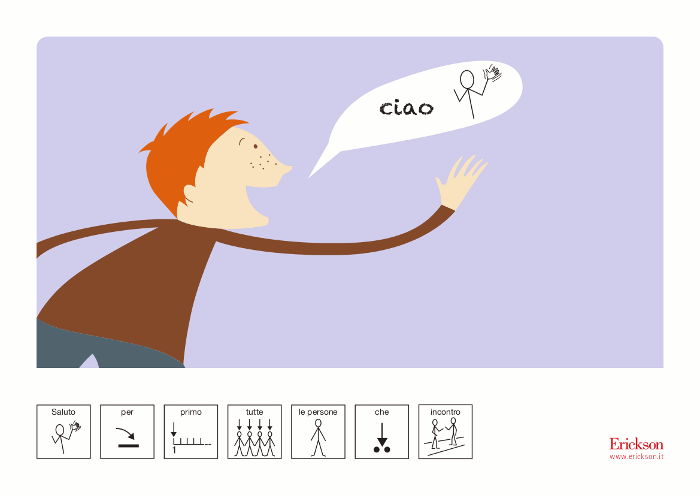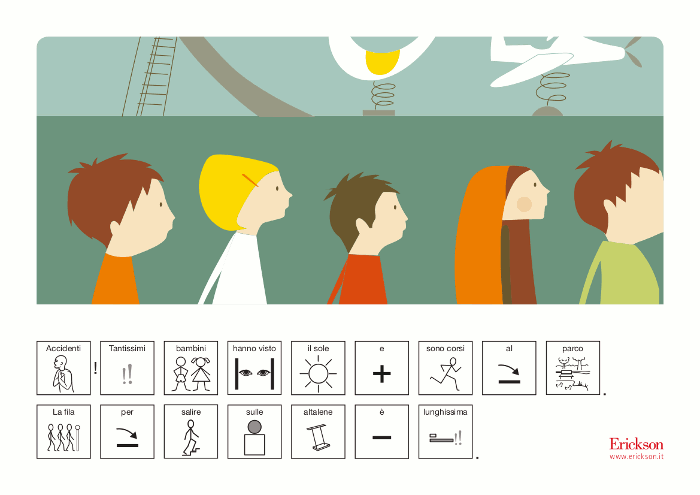 EN
EN
 PT
PT
Three IN-books for children aged 3-6: "The mole Clotilda and her formidable nose", "Clarabella, the dew drop", "Appointment in space"
Product: Book
Trim size in cm: 29,7x21
Pages: 80 colourful pages
ISBN: 9788859005384
Publication date: 01/05/2014
Suitable for: Nursery 1st Level (ages 3-4), Nursery 2nd Level (ages 4-5)
REQUEST A SAMPLE OR MORE INFORMATION
Stories with AAC 3 is a collection containing three IN-books with the same number of short and simple— but at the same time delightful — colour-illustrated stories for children aged 3-6. IN-books are illustrated books whose text is written entirely in symbols, designed to be listened to whilst an adult reads them out loud. They have been created for children with complex communicative needs and come from an Italian experience of Augmentative Communication, with the contribution of parents, teachers and professionals. The characteristics of the stories, the inclusion of the symbols and the pointing used during reading are elements which hold shared attention and make it easier to follow the story, with significant advantages for emotional, linguistic and cognitive development, making IN-books something to be treasured by all children, not only those with communication difficulties.
The three stories (The mole Clotilda and her formidable nose; Clarabella, the dew drop; and Appointment in space) deal with the themes of welcoming, friendship, adventure and courage through the vicissitudes of their characters.
The book also contains an easy-to-use «Reading guide» for parents, teachers and professionals, with instructions on how, where, when and how much to read IN-books with children.
The book is part of the series AAC: Augmentative and Alternative Communication, dedicated to this kind of communication which substitutes/integrates/improves oral verbal language, aiming at compensating for disability in expressive language.
Reading guide (edited by Maria Antonella Costantino)
Three stories:
The mole Clotilda and her formidable nose
Clarabella, the dew drop
Appointment in space

What are in-books?
They are illustrated books with text written entirely in symbols, designed to be listened to whilst another person reads out loud.
How did they come about?
They came about from an Italian experience of Augmentative and Alternative Communication (AAC), with the help of parents, teachers and operators, and they started appearing spontaneously and rather unexpectedly in houses, nursery schools, libraries and many other places. They have since become an important resource for all children, not only those with a communication disability.
How do you read in-books

The most specific element in reading books with symbols out loud is the use of modelling. The person reading constantly moves their finger over the symbols one by one as they read, trying not to let this movement interfere with the liveliness of the story telling. Your finger should be placed beneath the symbol so that both the symbol and the written word, which is placed above so that your finger does not cover it, can be clearly seen. Sometimes, during reading, you can point out details in the picture as well as the symbol, in order to emphasise key moments in the story. It is generally an adult who reads and points at the symbols, whilst the child or children listen.
What do the symbols mean?

Sometimes children want to point to the symbols whilst the adult reads and they enjoy controlling the adult's reading. Some children need to hold the adult's hand during modelling and to feel the movement and rhythm of the reading. The opposite, however, is not recommended - in other words the adult taking the child's hand and moving it passively. Children are never asked to look or point themselves: they are simply «exposed» to the continued pointing, one symbol at a time, in a playful manner. Pointing provides considerable support in capturing the attention of another person and creating shared attention in an environment of common reference. The continued movement of pointing from one symbol to the next accompanies the child's gaze symbol by symbol and facilitates sequence building.
Both transitions are particularly important for children who have difficulties, above all those with praxic and gaze tracking difficulties, like in children with autism spectrum disorders. With the latter, you may initially get the impression that they are not looking or following. If the book is motivating and attracts their attention, you just need to be patient and wait.
The advantages of modelling

In general, children quickly learn how modelling works, they only need to see an adult pointing at the symbols a couple of times before they start doing the same, automatically and naturally imitating what they have seen being done. They thus start to use modelling spontaneously to read IN-books, to themselves or out loud to other children. Through progressive modelling, and without the need for explanations and reminders, they automatically learn the correspondence between the word heard, the symbol and the written word. Reading books with symbols from this viewpoint becomes one of their first «grown-up» activities and children can start to do it on their own, without the constant mediation of an adult. The structure of IN-books enables children to «read» the symbols on their own. Although in the beginning they tend to enjoy the reading out loud and modelling done by an adult they soon learn to appreciate the possibility of enjoying the book on their own. It is not rare to see children who, despite not having developed the function of alphabetic reading, read to each other out loud, pointing at and recognising one by one the symbols in the text, thus supporting their future development of alphabetic reading and writing.
To find out more about AAC and in-books